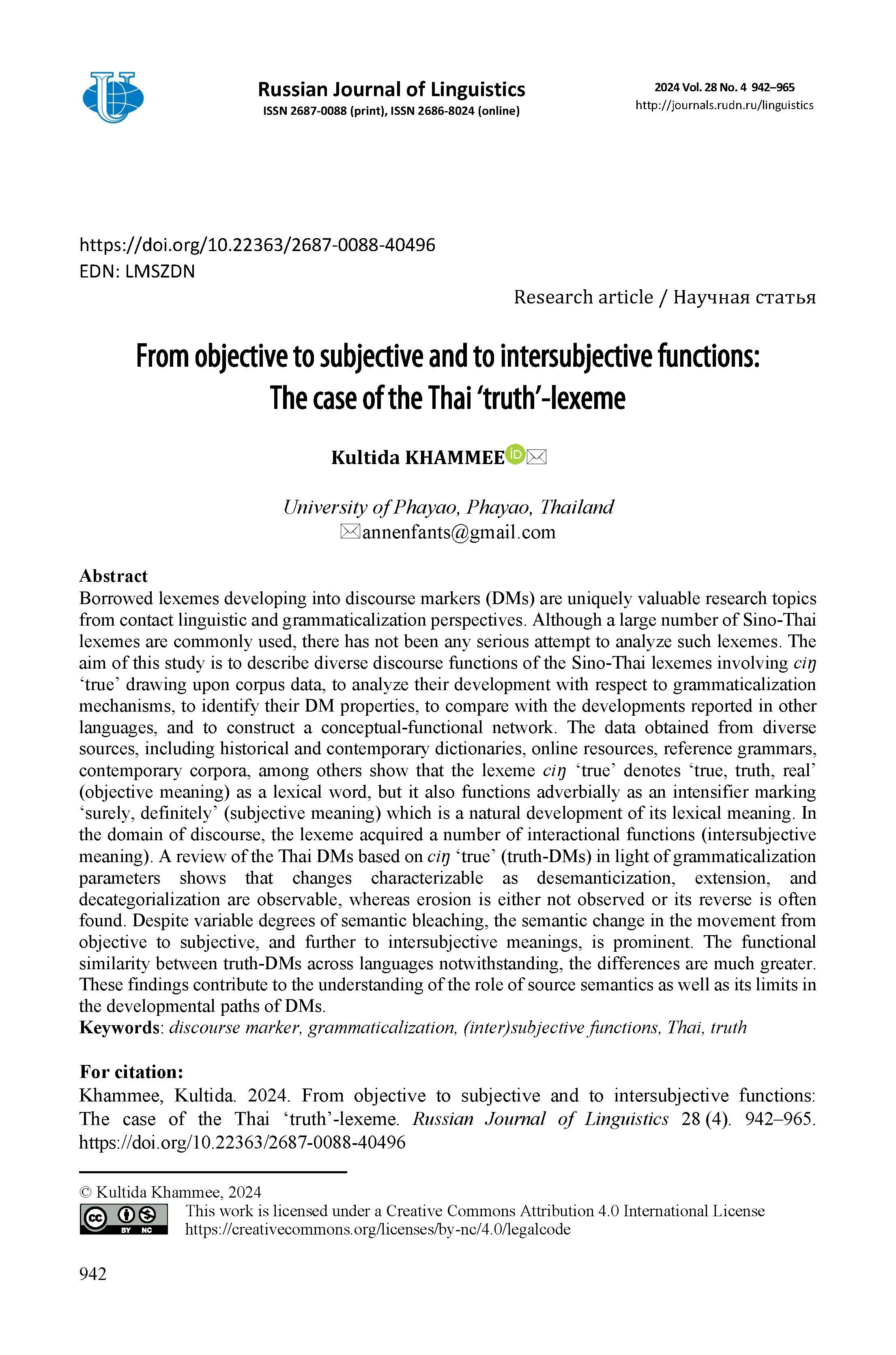From objective to subjective and to intersubjective functions: The case of the Thai ‘truth’-lexeme

From objective to subjective and to intersubjective functions: The case of the Thai ‘truth’-lexeme
โดย : kittipon.ja / 6 ส.ค. 2025 / อ่าน 54From objective to subjective and to intersubjective functions: The case of the Thai ‘truth’-lexeme
Abstract
Borrowed lexemes developing into discourse markers (DMs) are uniquely valuable research topics
from contact linguistic and grammaticalization perspectives. Although a large number of Sino-Thai
lexemes are commonly used, there has not been any serious attempt to analyze such lexemes. The
aim of this study is to describe diverse discourse functions of the Sino-Thai lexemes involving ciŋ
‘true’ drawing upon corpus data, to analyze their development with respect to grammaticalization
mechanisms, to identify their DM properties, to compare with the developments reported in other
languages, and to construct a conceptual-functional network. The data obtained from diverse
sources, including historical and contemporary dictionaries, online resources, reference grammars,
contemporary corpora, among others show that the lexeme ciŋ ‘true’ denotes ‘true, truth, real’
(objective meaning) as a lexical word, but it also functions adverbially as an intensifier marking
‘surely, definitely’ (subjective meaning) which is a natural development of its lexical meaning. In
the domain of discourse, the lexeme acquired a number of interactional functions (intersubjective
meaning). A review of the Thai DMs based on ciŋ ‘true’ (truth-DMs) in light of grammaticalization
parameters shows that changes characterizable as desemanticization, extension, and
decategorialization are observable, whereas erosion is either not observed or its reverse is often
found. Despite variable degrees of semantic bleaching, the semantic change in the movement from
objective to subjective, and further to intersubjective meanings, is prominent. The functional
similarity between truth-DMs across languages notwithstanding, the differences are much greater.
These findings contribute to the understanding of the role of source semantics as well as its limits in
the developmental paths of DMs.
Borrowed lexemes developing into discourse markers (DMs) are uniquely valuable research topics
from contact linguistic and grammaticalization perspectives. Although a large number of Sino-Thai
lexemes are commonly used, there has not been any serious attempt to analyze such lexemes. The
aim of this study is to describe diverse discourse functions of the Sino-Thai lexemes involving ciŋ
‘true’ drawing upon corpus data, to analyze their development with respect to grammaticalization
mechanisms, to identify their DM properties, to compare with the developments reported in other
languages, and to construct a conceptual-functional network. The data obtained from diverse
sources, including historical and contemporary dictionaries, online resources, reference grammars,
contemporary corpora, among others show that the lexeme ciŋ ‘true’ denotes ‘true, truth, real’
(objective meaning) as a lexical word, but it also functions adverbially as an intensifier marking
‘surely, definitely’ (subjective meaning) which is a natural development of its lexical meaning. In
the domain of discourse, the lexeme acquired a number of interactional functions (intersubjective
meaning). A review of the Thai DMs based on ciŋ ‘true’ (truth-DMs) in light of grammaticalization
parameters shows that changes characterizable as desemanticization, extension, and
decategorialization are observable, whereas erosion is either not observed or its reverse is often
found. Despite variable degrees of semantic bleaching, the semantic change in the movement from
objective to subjective, and further to intersubjective meanings, is prominent. The functional
similarity between truth-DMs across languages notwithstanding, the differences are much greater.
These findings contribute to the understanding of the role of source semantics as well as its limits in
the developmental paths of DMs.
